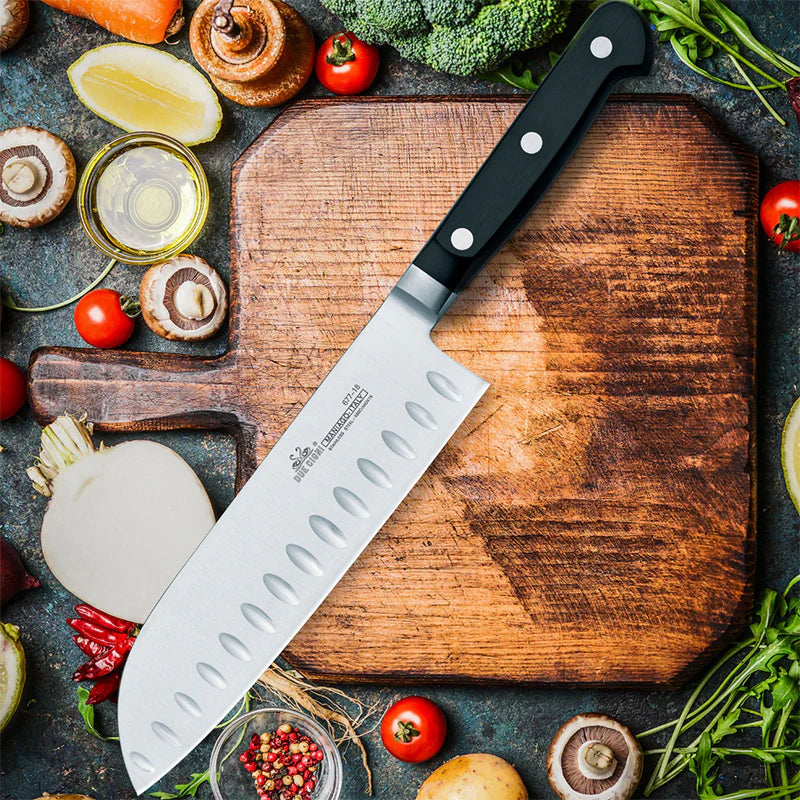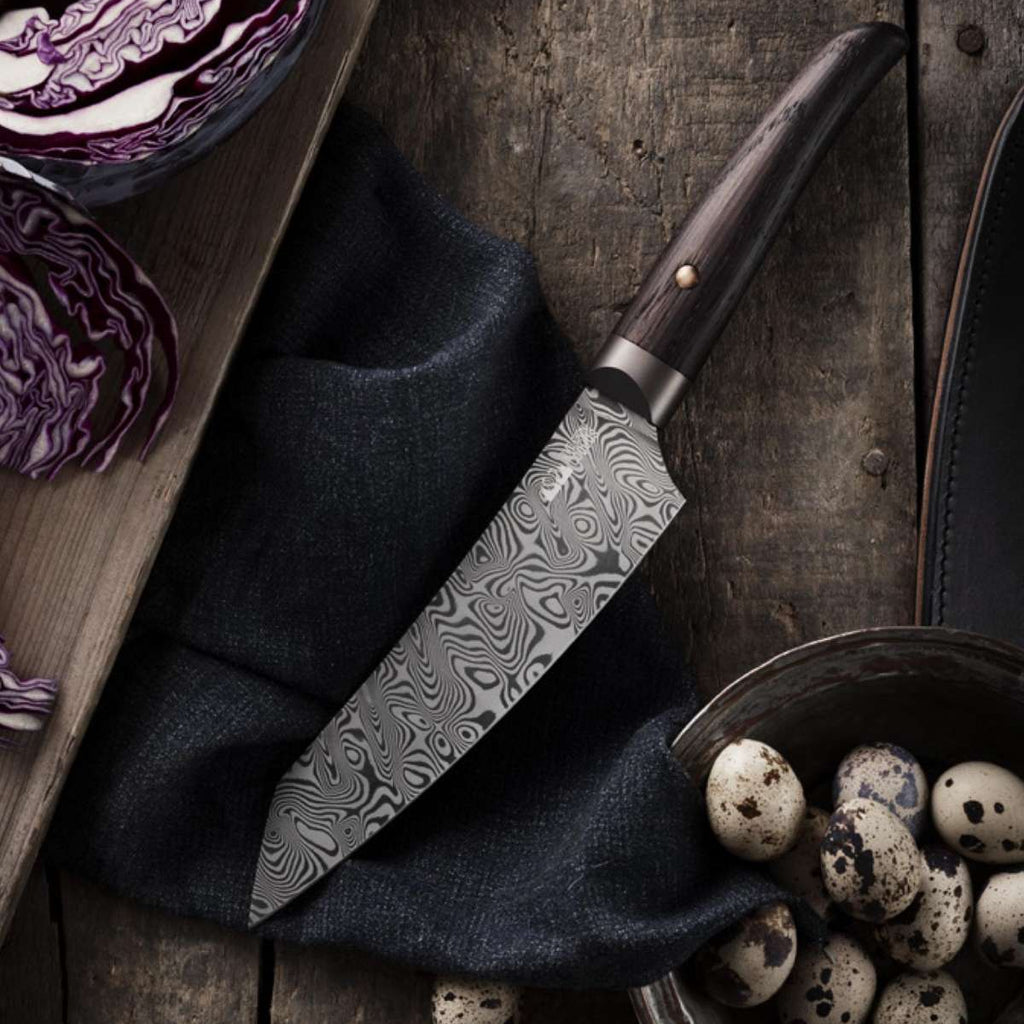Categories
Recent Articles
-
6 Steps to Sterilizing Pruning Shears March 08, 2024
-
How To Cut a Bell Pepper February 26, 2024
-
How To Cut Brisket February 26, 2024
Featured Products
How to use Santoku knife
In the realm of kitchen knives, the Santoku knife stands as a versatile and indispensable tool, known for its precision and ease of use. Originating in Japan, the Santoku knife has gained widespread popularity worldwide due to its unique design and functionality. In this comprehensive guide, we'll explore the art of using a Santoku knife, from understanding its anatomy to mastering various cutting techniques. Whether you're a seasoned chef or a novice cook, this article will help you unlock the full potential of this remarkable kitchen tool.
Understanding the Santoku Knife
Before diving into the techniques, it's essential to familiarize yourself with the Santoku knife's anatomy. Unlike a traditional chef's knife, the Santoku knife has distinct features that set it apart:
Blade Shape and Size
The Santoku knife typically features a shorter blade, ranging from 5 to 7 inches in length. Its blade has a flat edge and a rounded tip, offering a controlled and precise cutting surface.
Blade Thickness
Santoku knives have thin blades with a more acute edge angle, which enhances their slicing capabilities. This thinness reduces resistance during cuts, allowing for smoother and cleaner slices.
Blade Grind
Most Santoku knives feature a double-bevel edge, similar to Western knives. However, some traditional Japanese Santoku knives have a single-bevel edge, making them suitable for specialized tasks.
Weight and Balance
Santoku knives are lighter than traditional chef's knives, making them easier to handle and control. The balance typically leans toward the blade's center, offering excellent maneuverability.
Techniques for Using a Santoku Knife
Now that you have a grasp of the Santoku knife's anatomy, let's delve into the techniques that will help you make the most of this versatile tool:
The Basic Grip
Hold the Santoku knife correctly to ensure safe and precise cutting. Follow these steps:
- Position your dominant hand's index and middle fingers on the blade's spine, near the bolster (the junction between the blade and handle).
- Place your thumb on the opposite side, resting it against the blade.
- Your remaining fingers should grip the handle comfortably.
- Maintain a firm but relaxed grip to maintain control.
Slicing
- Slicing is one of the Santoku knife's strengths, allowing you to achieve thin and even cuts. Follow these steps for effective slicing:
- Begin by ensuring your cutting board is stable and secure.
- Place the food item you wish to slice on the cutting board.
- Hold the Santoku knife with the basic grip and use a gentle rocking motion.
- Start at the tip of the blade and gradually work your way back while applying slight downward pressure.
- Maintain a consistent angle and rhythm to achieve uniform slices.
Dicing
Dicing involves creating small, uniform cubes or pieces. Here's how to do it with a Santoku knife:
- Begin with a stable cutting board and the food item to be diced.
- Hold the Santoku knife with the basic grip.
- Start by making parallel slices into the food, leaving a small portion uncut near the base.
- Next, make perpendicular cuts to create a grid pattern.
- The result should be evenly sized diced pieces.
Chopping
Chopping with a Santoku knife is efficient and precise, thanks to its balanced design. Follow these steps:
- Place your food item on the cutting board.
- Hold the knife with the basic grip.
- Use a gentle up-and-down rocking motion to chop the food.
- Keep your fingers tucked in, using your knuckles as a guide for the blade.
Precision Cutting
The Santoku knife excels in precision tasks like julienning or brunoise. Here's how to perform these techniques:
- Ensure you have a stable cutting board and the desired food item.
- Hold the Santoku knife with the basic grip.
- Make thin, controlled cuts with a gentle rocking motion.
- For julienne cuts, create thin strips. For brunoise, create small, uniform cubes.
Care and Maintenance
Proper care and maintenance are crucial to keeping your Santoku knife in top-notch condition for years to come. Follow these tips:
Hand Washing
- After use, wash the Santoku knife with mild detergent and warm water.
- Avoid using abrasive scrubbers or putting it in the dishwasher, as this can damage the blade.
Drying
- Dry the knife thoroughly with a clean towel to prevent rust and corrosion.
- Store it in a knife block, magnetic strip, or blade guard to protect the edge.
Sharpening
- Regularly sharpen your Santoku knife using a sharpening stone or honing rod.
- Seek professional sharpening services as needed to restore the blade's sharpness.
Conclusion
Mastering the art of using a Santoku knife is a rewarding journey for any home cook or professional chef. With its precision, versatility, and ease of use, the Santoku knife can elevate your culinary creations to new heights. Whether you're slicing, dicing, chopping, or performing precision cuts, the Santoku knife's unique design and balanced feel will become an indispensable tool in your kitchen. Remember to care for it properly, and it will serve you faithfully for countless meals, allowing you to explore the world of culinary precision with confidence and finesse.











